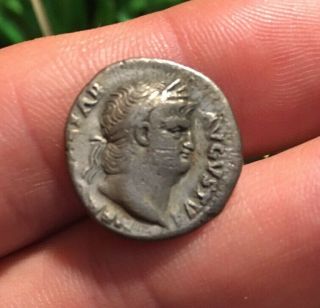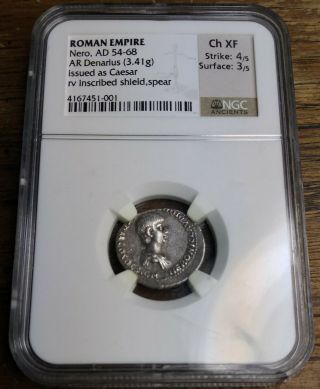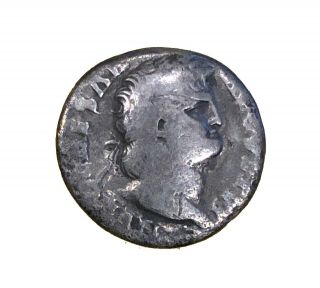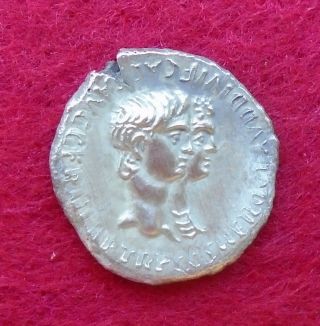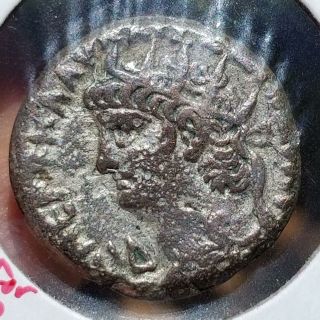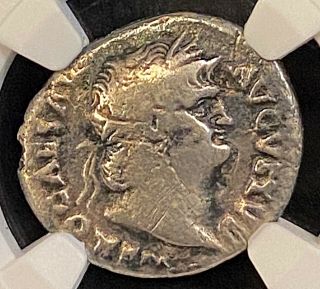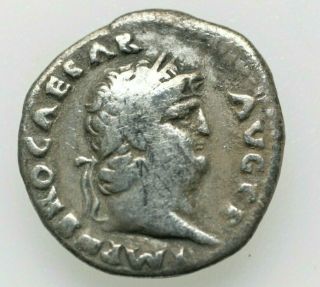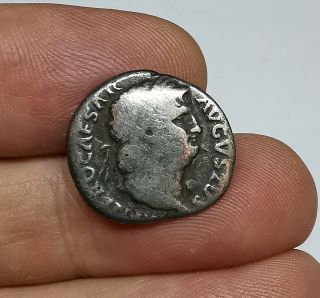NERO 54 - 68AD Vesta Silver Denarius LAST ONE
Item History & Price
| Reference Number: Avaluer:10049764 | Country//Region of Manufacture: United States |
LAST ONE
NERO 54-68AD “REPLICA” DENARIUS
Nero 54-68 AD. Silver Denarius,
Obverse: NERO CAESAR AVGVSTVS Portrait of NERO.
Reverse: VESTA Hexastyle temple of Vesta with domed roof& statue of Vesta within. Vesta the goddess of the public hearts (Hestia). Attendedby twenty priestesses, The Vesta Virgins, who ensured that the fire on heraltar burned continuously. Vesta was the greatest of these spirits, and lookedafter the entire population as an extended family of sor...ts.
Nero Claudius Caesar Augustus Germanicus (15 December 37–9June 68), born Lucius Domitius Ahenobarbus, also called (50 - 54 AD) NeroClaudius Drusus Germanicus, was the fifth and last Roman Emperor of theJulio-Claudian dynasty. On February 25, 50 he became heir to the then-RomanEmperor, his grand-uncle and adoptive father Claudius, as Nero Claudius CaesarDrusus. He succeeded to the throne on October 13, 54. In 66 he added the prefixImperator to his name. In 68 Nero was deposed. His death was reportedly theresult of suicide assisted by his scribe Epaphroditos (Greek for"lovely" and "charming").
Born in Antium (modern day Anzio), he was the only son ofGnaeus Domitius Ahenobarbus and Agrippina the younger, sister and reputed loverof Caligula
Nero wasproclaimed an adult in 51 at the age of 14. He was appointed proconsul, enteredand first addressed the Senate, made joint public appearances with Claudius, and was featured in coinage. In 53 he married his adoptive sister Octavia.
Claudius died on October 13, 54 and Nero was soonestablished as Augustus in his place. He was 17 years old, the youngest Emperoryet. Historians generally consider Nero to have acted as a figurehead early inhis reign. Actual decisions were likely to have been left at the more capablehands of his mother Agrippina the younger (who might have poisoned Claudius tohis death), his tutor Lucius Annaeus Seneca, and the praefectus praetorianusSextus Afranius Burrus. The first five years under Nero became known asexamples of fine administration, even resulting in coining the term "QuinquenniumNeronis".
The matters of the Empire were handled effectively and theSenate enjoyed a period of renewed influence in state affairs. However problemswould soon arise from Nero's personal life and the increasing competition forinfluence among Agrippina and the two male advisors. Nero was reportedlyunsatisfied with his marriage and tended to neglect Octavia. He entered anaffair with Claudia Acte, a former slave, in 55 AD. Agrippina attempted tointervene in favor of Octavia and demanded that her son dismiss Acte. Burrusand Seneca, on the other hand, chose to support their charge's decision.
Nero resisted the intervention of his mother in his personalaffairs. With her influence over her son declining, Agrippina turned to ayounger candidate for the throne. Fifteen-year-old Britannicus was stilllegally a minor under the charge of Nero but was approaching legal adulthood.Britannicus was a likely heir to Nero and ensuring her influence over him couldstrengthen her position. However the youth died suddenly on February 12, 55.His proclamation as an adult had been set for February 13. The timing suggestspoisoning. Burrus is suspected to have been involved in this murder. As Nerogrew angrier of Agrippina’s unofficial rule through him, he began to plot hisown mother’s murder by justifying his tactics by claiming she was conspiringagainst him which was not the case (“Agrippina the Younger” n.p.). Agrippina'spower soon further declined while Burrus and Seneca jointly became the mostinfluential men in Rome.
While his advisors tookcare of affairs of state, Nero surrounded himself with a circle of favorites.Roman historians report nights of drunken revelry and violence while moremundane matters of politics were neglected. Among his new favorites was MarcusSalvius Otho. By all accounts Otho was as dissolute as Nero but served as agood and intimate friend to him. Some sources even consider them to be lovers.Otho would soon introduce Nero to a woman who would marry first the favoriteand then the Emperor. Poppaea Sabina was described as a woman of great beauty, charm, and wit. Gossip of Nero, Otho, and Poppaea being parts of a lovetriangle can be found in many sources (Plutarch Galba 19.2-20.2; Suetonius Otho3.1-2; Tacitus two versions: Histories 1.13.3-4; Annals 13.45-46; and DioCassius 61.11.2-4).
By 58, Poppaea had been established in her position as thefavorite mistress of Nero. The following year (59) would mark a turning pointin the reign of Nero. Nero and/or Poppaea reportedly machinated the murder ofAgrippina. Seneca attempted to convince the Senate that she was orchestrating aconspiracy against her son, but the reputation of the Emperor was damagedbeyond repair by this case of matricide. Otho was soon also removed from theimperial environment, and sent to Lusitania as governor.
The next turning point would be the year 62, for severalreasons.
The first of them would be a change of guard in hisadvisors. Burrus died and Seneca asked Nero for permission to retire frompublic affairs. Their replacement as praetorian praefect and counselorrespectively was Gaius Ofonius Tigellinus . He had been exiled in 39 byCaligula on charges of adultery with both Agrippina and Livilla. He had beenrecalled from exile by Claudius and had later managed to become a favorite ofNero (and, reputedly, a lover). Along with Poppaea he was considered to holdgreater influence with the Augustus than Seneca ever could. In 62 Burrus diedand Seneca retired; Nero remained without his counselors; a few months later hemarried Poppaea. One theory suggests that Poppaea attempted, in those fouryears (58-62), to separate Nero from his counselors and friends; in this case, what happened to Burrus and Seneca may not have been casual.
The second significant event of the year was the divorce ofthe Emperor. Nero was now twenty-five years old, had reigned for eight years, and had yet to produce an heir. When Poppaea became pregnant, Nero finallydecided to marry his mistress, but his marriage to Octavia had to be dissolvedbefore doing so. At first he resorted to accusing her of adultery. However, Nero had already gained a reputation for this offence while Octavia was reputedto be an example of virtue. Some testimony was needed against her, buttorturing one of her slaves only produced the famous declaration of Pythiasreporting the genitalia of Octavia to be cleaner than the mouth of Tigellinus.Nero proceeded to declare the divorce on grounds of infertility, leaving himfree to marry Poppaea and wait for her to give birth. However, the sudden deathof Octavia on June 9, 62 resulted in incidents of public protest.
One of the earliest effects of Tigellinus' advancement wasthe introduction of a series of treason laws; numerous capital sentences werecarried out. During the year Nero executed two of his few remaining relatives:
Gaius Rubellius Plautus. His mother Claudia Julia wasgranddaughter to Tiberius and Vipsania Agrippina through their son JuliusCaesar Drusus. She was also granddaughter to Drusus and Antonia Minor throughtheir daughter Livilla.
Faustus Cornelius Sulla Felix. He was a grandson to LuciusDomitius Ahenobarbus and Antonia Major through their daughter Domitia Lepida.He was also maternal half-brother to Messalina. He had married Claudia Antonia, only daughter of Claudius and Aelia Paetina.
Early in 63 Poppaea gave birth to a daughter: ClaudiaAugusta. Nero celebrated the event but the child died four months later. Nerowas still with no heir.
On the night July 18 to July 19, 64 the Great fire of Romeerupted. The fire started in densely populated areas like the Suburra, in whichhad been built the insulae, sort of modern condominiums on 3 or 4 floors, madeof wood. Nero was reportedly vacationing in his native Anzio but had to returnin haste. The fire burned for a week. Rumour circulated that Nero had playedhis lyre and sang, on top of Quirinal Hill, while the city burned. (Tacitus, Ann. XV; Suetonius, Nero XXXVIII; Dio Cassius, R.H. LXII). Over the years, thisturned to a legend that Nero had fiddled as Rome burned, an impossible act asthe fiddle had not yet been invented. The same accounts depict him opening hispalaces to provide shelter for the homeless and arranging for food supplies tobe delivered in order to prevent starvation among the survivors. However, Nerolost his chances at redeeming his reputation when he immediately produced plansof rebuilding Rome in a monumental -- and less inflammable -- style.
The confused population was searching for scapegoats andsoon rumors held Nero responsible. The motivation attributed to him wasintending to immortalize his name by renaming Rome to "Neropolis".Nero had to engage in scapegoating of his own and chose for his target a smallEastern sect called Christians. He ordered known Christians to be thrown to thelions in arenas, while others were crucified in large numbers. It is apossibility that some parts of the Book of Revelation in the New Testamentdescribes the Antichrist as similar to Nero, and may have been written byChristians to express bitterness over Nero's bloody repression of the sect.
Gaius Cornelius Tacitus, a Roman historian, has preserved arecord of this affair. We quote the following from his Annals (XV.44):
"And so, to get rid of this rumor, Nero set up [i.e., falsely accused] as the culprits and punished with the utmost refinement ofcruelty a class hated for their abominations, who are commonly calledChristians. Nero’s scapegoats (the Christians) were the perfect choice becauseit temporarily relieved pressure of the various rumors going around Rome”(“Nero” n.p.). Christus, from whom their name is derived, was executed at thehands of the procurator Pontius Pilate in the reign of Tiberius. Checked for amoment, this pernicious superstition again broke out, not only in Judea, thesource of the evil, but even in Rome.... Accordingly, arrest was first made ofthose who confessed; then, on their evidence, an immense multitude wasconvicted, not so much on the charge of arson as because of [their] hatred forthe human race. Besides being put to death they were made to serve as objectsof amusement; they were clothed in the hides of beasts and torn to death bydogs; others were crucified, others set on fire to serve to illuminate thenight when daylight failed. Nero had thrown open his grounds for the display, and was putting on a show in the circus, where he mingled with the people inthe dress of charioteer or drove about in his chariot. All this gave rise to afeeling of pity, even towards men whose guilt merited the most exemplarypunishment; for it was felt that they were being destroyed not for the publicgood but to gratify the cruelty of an individual."
It is entirely unknown who or what was the cause of thefire. Although our ancient sources (and scholars) favor Nero as the arsonist, it is worth pointing out that fires were common in ancient Rome. His famousDomus Aurea was part of his rebuilding plan.
In 65 Nero was involved in another scandal, considered moreserious by the people of that era, than it would be now. It was consideredshameful for a Roman emperor to appear as a public entertainer, acting, singingand playing his lyre.
Hated by many citizens, with an increasing list of politicalenemies, Nero started to appreciate his loneliness, when in 65 he discoveredthe Pisonian conspiracy (named after Gaius Calpurnius Piso, who intended totake his place) and the involvement of old friends like Seneca in the plot.Conspirators were forced into suicide.
In addition, Nero ordered that Gnaeus Domitius Corbulo, apopular and valuable general, commit suicide because of the mere suspicion ofnew threats. This decision moved military commanders, locally and in theprovinces, to start planning a revolution. Also at about this time, accordingto tradition, Nero personally ordered the crucifixion of Saint Peter and, later, the beheading of Saint Paul.
In 66 Poppaea died, supposedly by the hand of Nero himself.The emperor left for Greece, in 67, where he amused his hosts with otherartistic performances, while in Rome Nymphidius (a colleague of Tigellinus, taking the place of one of the Pisonian conspirators) was collecting thesupport of praetorians and senators.
Back in Rome after the tournée, Nero found quite a coldatmosphere; Gaius Julius Vindex, the governor of Gallia Lugdunensis, revolted, and this brought Nero to a paranoid hunt for eventual threats; in this state ofmind he ordered the elimination of any patrician with suspect ideas. His (once)faithful servant Galba, governor of Iberia (Portugal and Spain), was one ofthose dangerous nobles, so he ordered his death. Galba, lacking an alternativechoice, declared his loyalty to the Senate and the People of Rome, no longerrecognising Nero's power. Moreover, he started organising his own campaign forthe empire.
The Senate deposed Nero, who committed suicide on June 9, 68. It is said that he uttered these last words before stabbing himself in theneck: "What an artist the world is losing in me!" With his death, theJulio-Claudian Dynasty came to an end. Chaos ensued in the Year of the four emperors.
ALL ITEMS COME FROM A SMOKE FREE HOME AND ARE GUARATEED TO BE AS DESCRIBED. SILVER NOT SILVER PLATED.
00128
NERO 54-68AD “REPLICA” DENARIUS
Nero 54-68 AD. Silver Denarius,
Obverse: NERO CAESAR AVGVSTVS Portrait of NERO.
Reverse: VESTA Hexastyle temple of Vesta with domed roof& statue of Vesta within. Vesta the goddess of the public hearts (Hestia). Attendedby twenty priestesses, The Vesta Virgins, who ensured that the fire on heraltar burned continuously. Vesta was the greatest of these spirits, and lookedafter the entire population as an extended family of sor...ts.
Nero Claudius Caesar Augustus Germanicus (15 December 37–9June 68), born Lucius Domitius Ahenobarbus, also called (50 - 54 AD) NeroClaudius Drusus Germanicus, was the fifth and last Roman Emperor of theJulio-Claudian dynasty. On February 25, 50 he became heir to the then-RomanEmperor, his grand-uncle and adoptive father Claudius, as Nero Claudius CaesarDrusus. He succeeded to the throne on October 13, 54. In 66 he added the prefixImperator to his name. In 68 Nero was deposed. His death was reportedly theresult of suicide assisted by his scribe Epaphroditos (Greek for"lovely" and "charming").
Born in Antium (modern day Anzio), he was the only son ofGnaeus Domitius Ahenobarbus and Agrippina the younger, sister and reputed loverof Caligula
Nero wasproclaimed an adult in 51 at the age of 14. He was appointed proconsul, enteredand first addressed the Senate, made joint public appearances with Claudius, and was featured in coinage. In 53 he married his adoptive sister Octavia.
Claudius died on October 13, 54 and Nero was soonestablished as Augustus in his place. He was 17 years old, the youngest Emperoryet. Historians generally consider Nero to have acted as a figurehead early inhis reign. Actual decisions were likely to have been left at the more capablehands of his mother Agrippina the younger (who might have poisoned Claudius tohis death), his tutor Lucius Annaeus Seneca, and the praefectus praetorianusSextus Afranius Burrus. The first five years under Nero became known asexamples of fine administration, even resulting in coining the term "QuinquenniumNeronis".
The matters of the Empire were handled effectively and theSenate enjoyed a period of renewed influence in state affairs. However problemswould soon arise from Nero's personal life and the increasing competition forinfluence among Agrippina and the two male advisors. Nero was reportedlyunsatisfied with his marriage and tended to neglect Octavia. He entered anaffair with Claudia Acte, a former slave, in 55 AD. Agrippina attempted tointervene in favor of Octavia and demanded that her son dismiss Acte. Burrusand Seneca, on the other hand, chose to support their charge's decision.
Nero resisted the intervention of his mother in his personalaffairs. With her influence over her son declining, Agrippina turned to ayounger candidate for the throne. Fifteen-year-old Britannicus was stilllegally a minor under the charge of Nero but was approaching legal adulthood.Britannicus was a likely heir to Nero and ensuring her influence over him couldstrengthen her position. However the youth died suddenly on February 12, 55.His proclamation as an adult had been set for February 13. The timing suggestspoisoning. Burrus is suspected to have been involved in this murder. As Nerogrew angrier of Agrippina’s unofficial rule through him, he began to plot hisown mother’s murder by justifying his tactics by claiming she was conspiringagainst him which was not the case (“Agrippina the Younger” n.p.). Agrippina'spower soon further declined while Burrus and Seneca jointly became the mostinfluential men in Rome.
While his advisors tookcare of affairs of state, Nero surrounded himself with a circle of favorites.Roman historians report nights of drunken revelry and violence while moremundane matters of politics were neglected. Among his new favorites was MarcusSalvius Otho. By all accounts Otho was as dissolute as Nero but served as agood and intimate friend to him. Some sources even consider them to be lovers.Otho would soon introduce Nero to a woman who would marry first the favoriteand then the Emperor. Poppaea Sabina was described as a woman of great beauty, charm, and wit. Gossip of Nero, Otho, and Poppaea being parts of a lovetriangle can be found in many sources (Plutarch Galba 19.2-20.2; Suetonius Otho3.1-2; Tacitus two versions: Histories 1.13.3-4; Annals 13.45-46; and DioCassius 61.11.2-4).
By 58, Poppaea had been established in her position as thefavorite mistress of Nero. The following year (59) would mark a turning pointin the reign of Nero. Nero and/or Poppaea reportedly machinated the murder ofAgrippina. Seneca attempted to convince the Senate that she was orchestrating aconspiracy against her son, but the reputation of the Emperor was damagedbeyond repair by this case of matricide. Otho was soon also removed from theimperial environment, and sent to Lusitania as governor.
The next turning point would be the year 62, for severalreasons.
The first of them would be a change of guard in hisadvisors. Burrus died and Seneca asked Nero for permission to retire frompublic affairs. Their replacement as praetorian praefect and counselorrespectively was Gaius Ofonius Tigellinus . He had been exiled in 39 byCaligula on charges of adultery with both Agrippina and Livilla. He had beenrecalled from exile by Claudius and had later managed to become a favorite ofNero (and, reputedly, a lover). Along with Poppaea he was considered to holdgreater influence with the Augustus than Seneca ever could. In 62 Burrus diedand Seneca retired; Nero remained without his counselors; a few months later hemarried Poppaea. One theory suggests that Poppaea attempted, in those fouryears (58-62), to separate Nero from his counselors and friends; in this case, what happened to Burrus and Seneca may not have been casual.
The second significant event of the year was the divorce ofthe Emperor. Nero was now twenty-five years old, had reigned for eight years, and had yet to produce an heir. When Poppaea became pregnant, Nero finallydecided to marry his mistress, but his marriage to Octavia had to be dissolvedbefore doing so. At first he resorted to accusing her of adultery. However, Nero had already gained a reputation for this offence while Octavia was reputedto be an example of virtue. Some testimony was needed against her, buttorturing one of her slaves only produced the famous declaration of Pythiasreporting the genitalia of Octavia to be cleaner than the mouth of Tigellinus.Nero proceeded to declare the divorce on grounds of infertility, leaving himfree to marry Poppaea and wait for her to give birth. However, the sudden deathof Octavia on June 9, 62 resulted in incidents of public protest.
One of the earliest effects of Tigellinus' advancement wasthe introduction of a series of treason laws; numerous capital sentences werecarried out. During the year Nero executed two of his few remaining relatives:
Gaius Rubellius Plautus. His mother Claudia Julia wasgranddaughter to Tiberius and Vipsania Agrippina through their son JuliusCaesar Drusus. She was also granddaughter to Drusus and Antonia Minor throughtheir daughter Livilla.
Faustus Cornelius Sulla Felix. He was a grandson to LuciusDomitius Ahenobarbus and Antonia Major through their daughter Domitia Lepida.He was also maternal half-brother to Messalina. He had married Claudia Antonia, only daughter of Claudius and Aelia Paetina.
Early in 63 Poppaea gave birth to a daughter: ClaudiaAugusta. Nero celebrated the event but the child died four months later. Nerowas still with no heir.
On the night July 18 to July 19, 64 the Great fire of Romeerupted. The fire started in densely populated areas like the Suburra, in whichhad been built the insulae, sort of modern condominiums on 3 or 4 floors, madeof wood. Nero was reportedly vacationing in his native Anzio but had to returnin haste. The fire burned for a week. Rumour circulated that Nero had playedhis lyre and sang, on top of Quirinal Hill, while the city burned. (Tacitus, Ann. XV; Suetonius, Nero XXXVIII; Dio Cassius, R.H. LXII). Over the years, thisturned to a legend that Nero had fiddled as Rome burned, an impossible act asthe fiddle had not yet been invented. The same accounts depict him opening hispalaces to provide shelter for the homeless and arranging for food supplies tobe delivered in order to prevent starvation among the survivors. However, Nerolost his chances at redeeming his reputation when he immediately produced plansof rebuilding Rome in a monumental -- and less inflammable -- style.
The confused population was searching for scapegoats andsoon rumors held Nero responsible. The motivation attributed to him wasintending to immortalize his name by renaming Rome to "Neropolis".Nero had to engage in scapegoating of his own and chose for his target a smallEastern sect called Christians. He ordered known Christians to be thrown to thelions in arenas, while others were crucified in large numbers. It is apossibility that some parts of the Book of Revelation in the New Testamentdescribes the Antichrist as similar to Nero, and may have been written byChristians to express bitterness over Nero's bloody repression of the sect.
Gaius Cornelius Tacitus, a Roman historian, has preserved arecord of this affair. We quote the following from his Annals (XV.44):
"And so, to get rid of this rumor, Nero set up [i.e., falsely accused] as the culprits and punished with the utmost refinement ofcruelty a class hated for their abominations, who are commonly calledChristians. Nero’s scapegoats (the Christians) were the perfect choice becauseit temporarily relieved pressure of the various rumors going around Rome”(“Nero” n.p.). Christus, from whom their name is derived, was executed at thehands of the procurator Pontius Pilate in the reign of Tiberius. Checked for amoment, this pernicious superstition again broke out, not only in Judea, thesource of the evil, but even in Rome.... Accordingly, arrest was first made ofthose who confessed; then, on their evidence, an immense multitude wasconvicted, not so much on the charge of arson as because of [their] hatred forthe human race. Besides being put to death they were made to serve as objectsof amusement; they were clothed in the hides of beasts and torn to death bydogs; others were crucified, others set on fire to serve to illuminate thenight when daylight failed. Nero had thrown open his grounds for the display, and was putting on a show in the circus, where he mingled with the people inthe dress of charioteer or drove about in his chariot. All this gave rise to afeeling of pity, even towards men whose guilt merited the most exemplarypunishment; for it was felt that they were being destroyed not for the publicgood but to gratify the cruelty of an individual."
It is entirely unknown who or what was the cause of thefire. Although our ancient sources (and scholars) favor Nero as the arsonist, it is worth pointing out that fires were common in ancient Rome. His famousDomus Aurea was part of his rebuilding plan.
In 65 Nero was involved in another scandal, considered moreserious by the people of that era, than it would be now. It was consideredshameful for a Roman emperor to appear as a public entertainer, acting, singingand playing his lyre.
Hated by many citizens, with an increasing list of politicalenemies, Nero started to appreciate his loneliness, when in 65 he discoveredthe Pisonian conspiracy (named after Gaius Calpurnius Piso, who intended totake his place) and the involvement of old friends like Seneca in the plot.Conspirators were forced into suicide.
In addition, Nero ordered that Gnaeus Domitius Corbulo, apopular and valuable general, commit suicide because of the mere suspicion ofnew threats. This decision moved military commanders, locally and in theprovinces, to start planning a revolution. Also at about this time, accordingto tradition, Nero personally ordered the crucifixion of Saint Peter and, later, the beheading of Saint Paul.
In 66 Poppaea died, supposedly by the hand of Nero himself.The emperor left for Greece, in 67, where he amused his hosts with otherartistic performances, while in Rome Nymphidius (a colleague of Tigellinus, taking the place of one of the Pisonian conspirators) was collecting thesupport of praetorians and senators.
Back in Rome after the tournée, Nero found quite a coldatmosphere; Gaius Julius Vindex, the governor of Gallia Lugdunensis, revolted, and this brought Nero to a paranoid hunt for eventual threats; in this state ofmind he ordered the elimination of any patrician with suspect ideas. His (once)faithful servant Galba, governor of Iberia (Portugal and Spain), was one ofthose dangerous nobles, so he ordered his death. Galba, lacking an alternativechoice, declared his loyalty to the Senate and the People of Rome, no longerrecognising Nero's power. Moreover, he started organising his own campaign forthe empire.
The Senate deposed Nero, who committed suicide on June 9, 68. It is said that he uttered these last words before stabbing himself in theneck: "What an artist the world is losing in me!" With his death, theJulio-Claudian Dynasty came to an end. Chaos ensued in the Year of the four emperors.
ALL ITEMS COME FROM A SMOKE FREE HOME AND ARE GUARATEED TO BE AS DESCRIBED. SILVER NOT SILVER PLATED.
00128




